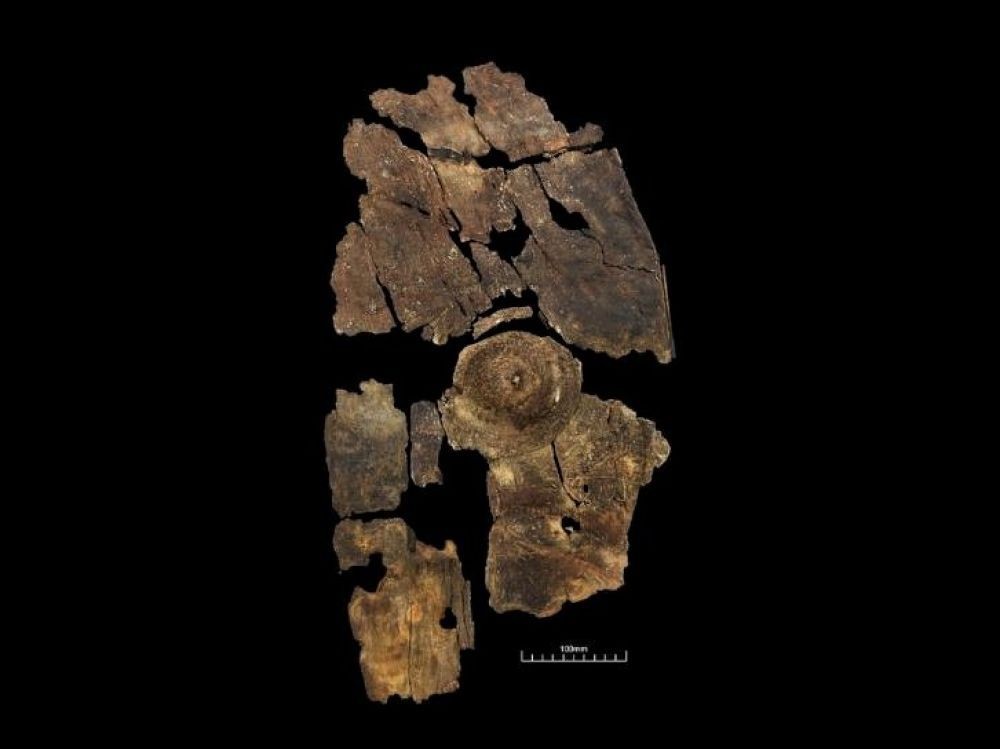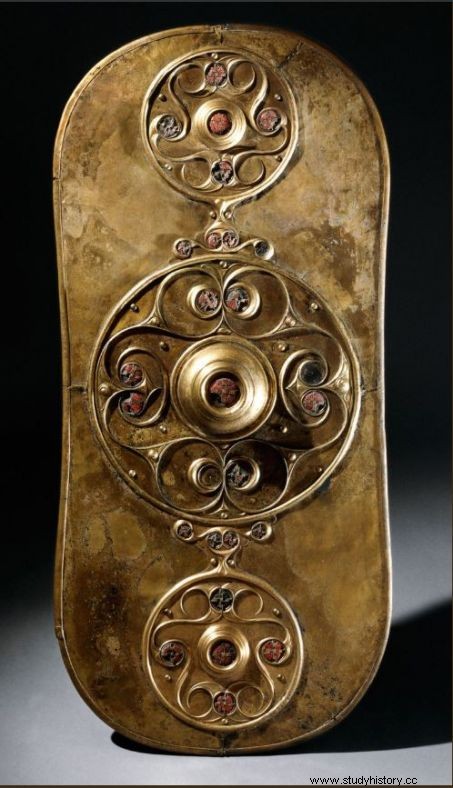Unique example, made of bark, a Celtic shield of the IV th century BC was unearthed in England.

Remains of the Celtic shield of Leicester, dated to 255-395 BCE.
It is an amazing Celtic shield, fashioned from tree bark and 2300 years old, that British archaeologists have discovered. A first in Europe where never such a specimen had been encountered! The researchers from the University of Leicester (ULAS) who just made the announcement, unearthed in 2015 the fragmented remains of this piece of weaponry dating back to 395-250 BCE, which had been marinating for centuries in waterlogged ground near the River Soar at the Everards Meadows site (south of England). Was it laid there as an offering? Had it been abandoned by its owner, too fragile to resist the repeated assaults of spears or swords of which it seemed to bear the traces?
For four years, experiments aimed at reconstructing this shield were then carried out under the direction of Matt Beamish. The study of its composition first revealed a complex assembly made from bark of alder, willow, poplar and hazel, reinforced by strips of fibrous wood from apple, lime, poplar and alder. The assembly was probably covered with several layers of leather to avoid bursting and to ensure the cohesion of the assembly. A checkerboard painted ornamentation decorated the outer part.

The shield as it appeared when it was discovered in 2015. ©ULAS
This experimental research has thus made it possible to discover that this element of bark armament, much less resistant than a solid wood or metal shield, was however much lighter, allowing its user to evolve with great freedom of movement. . And to establish that the famous Celtic warriors therefore did not only use metal shields, like the famous Battersea shield, exhibited at the British Museum in London, made up of large bronze plates.

The Celtic shield in bronze plates of Battersea (1st century BC), discovered in the 19th century. ©British Museum
“Contrary to popular belief, many Celtic shields were made of wood , explains Nathalie Ginoux, specialist in art and archeology of the Celtic worlds at the Center André Chastel (UMR 8150) at the University of Paris-Sorbonne. It was found in Clonoura, near Tipperary, Ireland – where a shield also showed signs of blows – in La Tène*, Switzerland, in Hjortspring, Denmark. Without forgetting this wooden shield found near Cairo, in Egypt, testifying to the great mobility of Celtic mercenaries (see box) in these regions and those of Asia Minor [a large-scale military phenomenon Editor’s note], around the III th century BC “, specifies the specialist of the second iron age.
But the specimen unearthed by British researchers is unique:“It is the only one we know of to date that has been fashioned from bark. It helps confirm historical sources “, continues the researcher. Thus this passage from The Gallic Wars (Book II) (Commentarii de Bello Gallico ) in which Julius Caesar notes:"[…] making use, on the one hand, of the weapons which they had retained and concealed, on the other of shields which they had made of bark or braiding the wicker they had immediately, seen the urgency, covered with skins, made on the third watch, on the side where the ascent towards our entrenchments was the least difficult, a sudden and massive exit /em> ". Wicker shields are also mentioned during the Battle of Lake Trasimeno (June 21, 217 BC) during the Second Punic War between the Roman troops of Consul Flaminius and the Carthaginian army of Hannibal Barca (which included contingents Celts). The Leicester Bark Shield is due to be presented to the British Museum soon.
*La Tène Culture , or Second Iron Age, is an archaeological culture that developed in Europe between approximately 450 and 25 BC. Considered the pinnacle of Celtic culture, it succeeded the Hallstatt culture (1300-400 BC)
Celtic Mercenary
A phenomenon of great magnitude for the "Celts", "Galatians" or "Gauls", as the ancient authors called them. More than 150 mentions of mercenaries or Celtic auxiliaries have been identified by some twenty of these authors. Their mentions reported in Greco-Latin sources range from the 5th century BC (-480, battle of Himera, in Sicily, until the end of the 1
st
century CE). “The acme of the phenomenon is in the 3rd century BC “, explains Luc Baray, director of research at the CNRS, which has devoted a book to them. “It was indeed during this century that the Celts had to intervene most frequently in the ranks of foreign armies, either in the context of the first two Punic Wars and in the theaters of operations in the western Mediterranean, or in the setting of the Epigonian Wars in Asia Minor ". In Antiquity, all periods combined, Celtic mercenaries were reported in Italy, Greece, Asia Minor, Thrace… as far as Babylonia, Sicily or northern Africa, and Egypt.
Find out more: "Celts, Galatians and Gauls, mercenaries of Antiquity", by Luc Baray, Picard editions, 2017.
